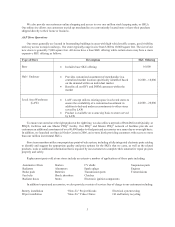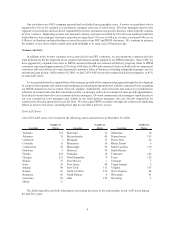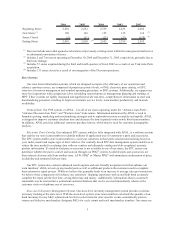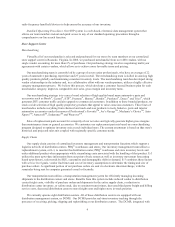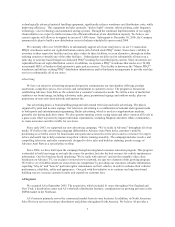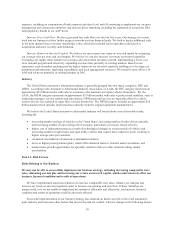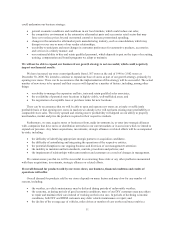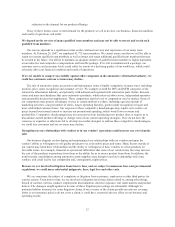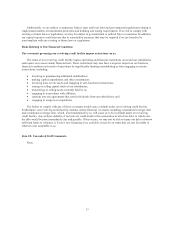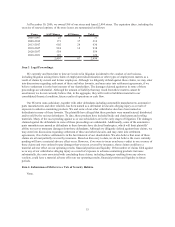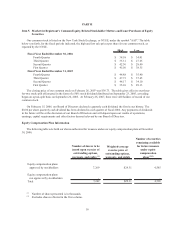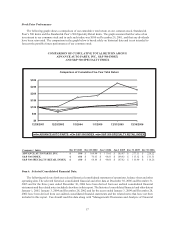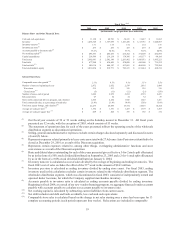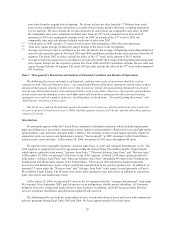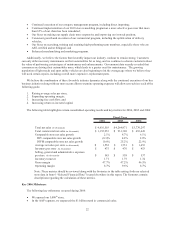Advance Auto Parts 2006 Annual Report Download - page 35
Download and view the complete annual report
Please find page 35 of the 2006 Advance Auto Parts annual report below. You can navigate through the pages in the report by either clicking on the pages listed below, or by using the keyword search tool below to find specific information within the annual report.reduction in the demand for our product offerings.
If any of these factors cause overall demand for the products we sell to decline, our business, financial condition
and results of operations will suffer.
We depend on the services of many qualified team members and may not be able to attract and retain such
qualified team members.
Our success depends to a significant extent on the continued services and experience of our many team
members. At February 26, 2007, we employed 43,772 team members. We cannot assure you that we will be able to
retain our current qualified team members as well as attract and retain additional qualified team members that may
be needed in the future. Our ability to maintain an adequate number of qualified team members is highly dependent
on an attractive and competitive compensation and benefits package. If we fail to maintain such a package, our
customer service and execution levels could suffer by reason of a declining quality of our workforce, which could
adversely affect our financial condition and results of operations.
If we are unable to compete successfully against other companies in the automotive aftermarket industry, we
could lose customers and our revenues may decline.
The sale of automotive parts, accessories and maintenance items is highly competitive in many ways, including
location, price, name recognition and customer service. We compete in both the DIY and DIFM categories of the
automotive aftermarket industry, and primarily with national and regional retail automotive parts chains, discount
stores and mass merchandisers that carry automotive products, wholesalers or jobber stores, independent operators
and automobile dealers that supply parts. These competitors and the level of competition vary by market. Some of
our competitors may possess advantages over us in certain markets we share, including a greater amount of
marketing activities, a larger number of stores, longer operating histories, greater name recognition or larger and
more established customer bases. Our response to these competitive disadvantages may require us to reduce our
prices beyond our normal control or increase our promotional spending, which would lower revenue and
profitability. Competitive disadvantages may also prevent us from introducing new product lines or require us to
discontinue current product offerings or change some of our current operating strategies. If we do not have the
resources or expertise or otherwise fail to develop successful strategies to address these competitive disadvantages,
we could lose customers and our revenues may decline.
Disruptions in our relationships with vendors or in our vendors' operations could increase our cost of goods
sold.
Our business depends on developing and maintaining close relationships with our vendors and upon the
vendors' ability or willingness to sell quality products to us at favorable prices and terms. Many factors outside of
our control may harm these relationships and the ability or willingness of these vendors to sell us products on
favorable terms. For example, financial or operational difficulties that some of our vendors may face may increase
the cost of the products we purchase from them or the ability for us to source product from them. In addition, the
trend towards consolidation among automotive parts suppliers may disrupt or end our relationship with some
vendors, and could lead to less competition and, consequently, higher prices.
Because we are involved in litigation from time to time, and are subject to numerous laws and governmental
regulations, we could incur substantial judgments, fines, legal fees and other costs.
We are sometimes the subject of complaints or litigation from customers, employees or other third parties for
various actions. From time to time, we are involved in litigation involving claims related to, among other things,
breach of contract, tortious conduct, employment discrimination, asbestos exposure, real estate matters and product
defects. The damages sought against us in some of these litigation proceedings are substantial. Although we
maintain liability insurance for some litigation claims, if one or more of the claims greatly exceeds our coverage
limits or our insurance policies do not cover a claim, it could have a material adverse affect on our business and
operating results.
12



